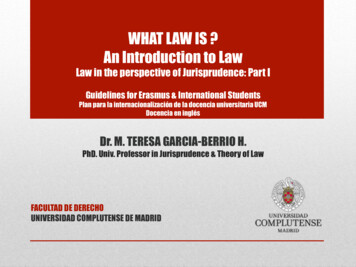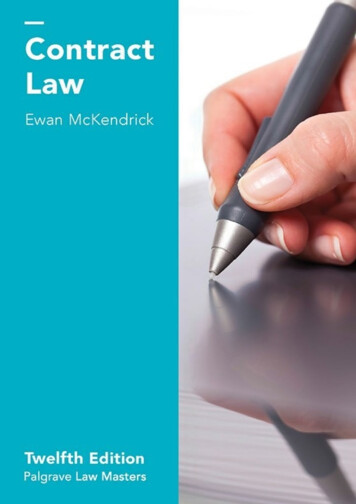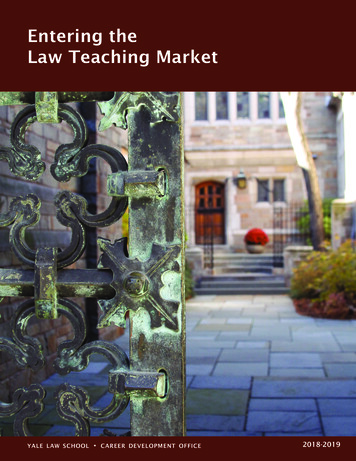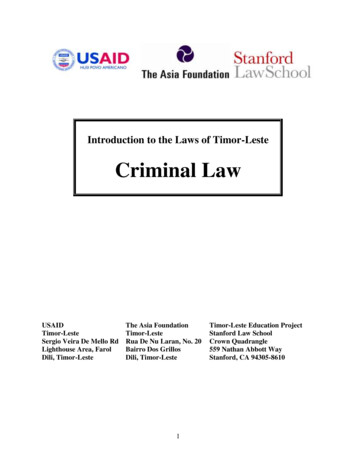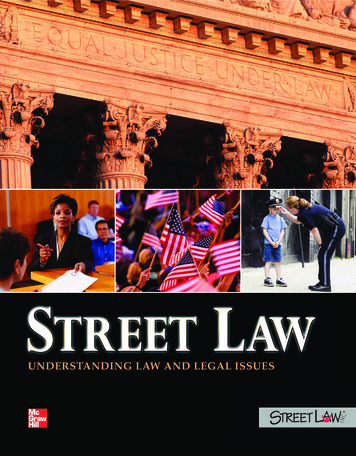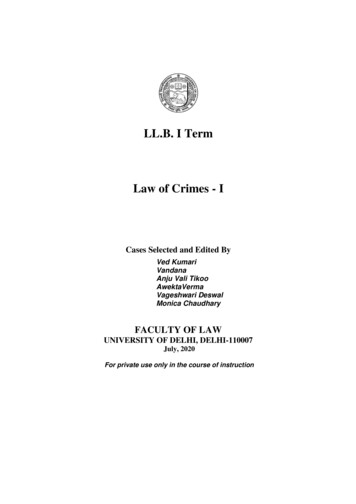
Transcription
LL.B. I TermLaw of Crimes - ICases Selected and Edited ByVed KumariVandanaAnju Vali TikooAwektaVermaVageshwari DeswalMonica ChaudharyFACULTY OF LAWUNIVERSITY OF DELHI, DELHI-110007July, 2020For private use only in the course of instruction
Course Wise Content Details for LL.B. Programme:Semester - FirstCourse Name- Law of Crimes- I : Indian Penal CodeCourse Code- LB-CC-104Credits – 5Total Classes 60 15Course Objectives:The primary objectives of this course are: To familiarise the students with the key concepts regarding crime and criminallaw. To expose the students to the range of mental states that constitute mens reaessential for committing crime and to teach specific offences under the IndianPenal Code. To familiarise the students with the concept of criminal liability and thevastness of its horizons. To keep students abreast of the latest legislative and judicial developments andchanges in the field of criminal law. Learning OutcomesThe students should be able to identify the concept of criminal liability asdistinguished from the civil liability.Identify the elements of crime in given factual situations entailing culpability.Be familiar with the range of Specific Offences (Bodily offences andProperty offences)Teaching Methodology:Classroom Teaching( Lecturing/Discussions)Class PresentationsCourse Content:Classroom Teaching with help of Legislation and Case Material.Prescribed legislation:The Indian Penal Code, 1860
Prescribed Books:K.T. Thomas, M.A. Rashid (Rev.), Ratan Lal & Dhiraj Lal’s The IndianthPenal Code, (35 ed., 2017)thK.D. Gaur, Criminal Law : Cases and Materials, (8 ed., 2015)R.C. Nigam, Law of Crimes in India (Vol. I) (1965)V.B. Raju, Commentary on Indian Penal Code, 1860 (Vol. I & II) (4ed., 1982)thK.N.C. Pillai & Shabistan Aquil (Rev.), Essays on the Indian PenalCode (The Indian Law Institute, 2005)thK. I. Vibhute (Rev.), P.S.A. Pillai’s Criminal Law (13 ed., 2017)Syed Shamsul Huda, The Principles of the Law of Crimes in British India(1902)K.N. Chandrasekharan Pillai, General Principles of Criminal Lawnd(2 ed., 2011)UNITSUnit 1 : Principle of Mens Rea and Strict Liability5 LecturesCommon Law principle of actus non facit reum, nisi mens sit rea and exceptions tothis principle - strict liability offencesNature of crimeElements of crime1.State of Maharashtra v. Mayer Hans George, (1965) 1 SCR 123 1 AIR1965 SC 7222.State of M.P. v. Narayan Singh, (1989) 3 SCC 596Unit 2 : (a) Culpable Homicide and Murder2316 Lectures(Sections 299-302, 304 read with sections 8-11, 21, 32, 33, 39, 52)Offences of culpable homicide amounting and not amounting to murderdistinguished. Culpable homicide of first degree provided in clause (a), second degreein clause (b) and third degree in clause (c) of section 299, IPC. Each clause of section
299 contains comparable clauses in section 300. Every murder is culpable homicidebut not vice versa. Culpable homicide is the genus and murder is its species.Intention - clause (a) of section 299 and clause (1) of section 3003.Rawalpenta Venkalu v. State of Hyderabad, AIR 1956 SC 17129Mens rea and actus reus-Relationship4.Palani Goundan v. Emperor, 1919 ILR 547 (Mad)335.In re Thavamani, AIR 1943 Mad 57140Cause and effect relationship- The act of the accused must be thecausal factor or direct cause of death (read with section 301, IPC)6.Emperor v. Mushnooru Suryanarayana Murthy(1912) 22 MLJR 333 (Mad.)42Comparison of clause (b) of section 299 with clause (3) of section 3007. Kapur Singh v. State of PEPSU, AIR 1956 SC 654548.Virsa Singh v. State of Punjab, AIR 1958 SC 465559.State of Andhra Pradesh v. R. Punnayya, AIR 1977 SC 4560Comparison of clause (c) of section 299 with clause (4) of section 300Distinction between intention and knowledge and role of knowledge in S.300secondly and then comparison of clause (c) of section 299 with clause (4) of section300.10.Emperor v. Mt. Dhirajia, AIR 1940 All. 4867011.Gyarsibai v. The State, AIR 1953 M.B. 6175Unit 3 : Specific Exceptions to section 3002 LecturesGeneral and partial defences distinguished – general defences in Chapter IV, IPC, ifapplicable in a given case, negate criminality completely.Partial defences such as exceptions to section 300 partly reduce the criminality, notabsolving an accused completely. The law, based on sound principle of reason, takes a
lenient view in respect of murders committed on the spur of the moment. Exceptions Ito V to section 300 are illustrative of partial defences.Exception I to section 30012.K.M. Nanavati v. State of Maharashtra, AIR 1962 SC 60579ReadingKatherine O’Donovan,‘Defences for Battered Women Who Kill’,18 (2) Journal of Law and Society 219 (1991)88Exception IV to section 30013.Ghapoo Yadav v. State of M.P, (2003) 3 SCC 52896Unit 4 : Homicide by Rash or Negligent Act not amounting to CulpableHomicide2 Lectures(Section 304A) Distinction between negligence and rashness as forms of mens rea;mens rea required is criminal negligence (inadvertent negligence) or criminalrashness (advertent negligence)14.Cherubin Gregory v. State of Bihar, AIR 1964 SC 20515.S.N. Hussain v. State of Andhra Pradesh, AIR 1972 SC 68599102Unit 5 : General Exceptions -Chapter IV of the Indian Penal Code 5 LecturesGeneral defences in Chapter IV, IPC, if applicable in a given case, negate criminalitycompletely.Private Defence (Sections 96-106, IPC)The right of private defence has come to be recognized by all civilized societies as apreventive and protective right where the state protection is not available; this right isessentially protective and preventive and never punitive. There are limitations on theexercise of this right both in relation to offences against human body and specificoffences against property. The extent of this right, against whom it can be exercised,when this right commences and how long it lasts are dealt with elaborately in IPC.16. State of U.P. v. Ram Swarup (1974) 4 SCC 764 :AIR 1974 SC 157010617. Deo Narain v. State of U.P. (1973) 1 SCC 347: AIR 1973 SC 473114
18. Kishan v. State of M.P. (1974) 3 SCC 623 : AIR 1974 SC 24411819. James Martin v. State of Kerala (2004) 2 SCC 203120Unit 6 : Kidnapping and Abduction (sections 359-363 read with sections 18, 82,83, 90)4 LecturesIngredients of the offence of kidnapping from lawful guardianship (section 362);distinction between taking, enticing and allowing a minor to accompany; Kidnappingfrom lawful guardianship is a strict liability offence (section 363) and distinctionbetween ‘Kidnapping’ and ‘Abduction’. Relevance of age, consent, force, deceptionand motive.20. S. Varadarajan v. State of Madras, AIR 1965 SC 94212721. Thakorlal D. Vadgama v. State of Gujarat, AIR 1973 SC 231313222. State of Haryana v. Raja Ram, (1973) 1 SCC 544 138143Unit 7 : Sexual Offences8 LecturesThe offence of rape (sections 375, 376, 376A-E read with section 90);Section 377 –Unnatural Offences ;Comparison to be made with the definitions in The Protection ofChildren from Sexual Offences Act, 2012.Section 354 (Assault or criminal force to woman with intent to outrage her modesty),section 354A (Sexual harassment), section 354B (Assault or use of criminal force towoman with intent to disrobe), section 354C (Voyeurism), section 354D (Stalking)and section 509 (Word, gesture or act intended to insult the modesty of a woman).23. Kanwar Pal Singh Gill v. State (Admn., U.T. Chandigarh)149through Secy., (2005) 6 SCC 16124.Tukaram v. State of Maharashtra, AIR 1979 SC 185153Reading: An Open Letter to the Chief Justice of India, (1979) 4 SCC (J) 1715925.State of Punjab v. Gurmit Singh, (1996) 2 SCC 384164*26.Independent Thought v. Union of India, (2017) 10 SCC 800.*27. Navtej Singh Johar v. Union of India Through Secretary, Ministry ofLaw and Justice, (2018) 10 SCC 1
Unit 8 : Joint Liability and Group Liability (Section 34, SectionsIPC)141, 1496 LecturesProvisions for providing for group liability in crimes including sections 34 and 149 ofthe IPC are exceptions to the general rule of criminal liability that a man should beheld liable for his own criminal acts and not for those of others. These provisionsproviding for vicarious liability/group liability are intended to deter people fromcommitting offences in groups and to spare the prosecution to prove specific actusreus of each member of the group28. Suresh v. State of U.P. (2001) 3 SCC 67317729. Mizaji v. State of U.P., AIR 1959 SC 57219030. Maina Singh v. State of Rajasthan (1976) 2 SCC 827: AIR 1976SC 1084196Unit 9 : Attempt (Sections 511, 307, 309 IPC)6 LecturesThere are four stages in the commission of crime – (i) intention to commit anoffence, (ii) preparation, (iii) attempt and (iv) forbidden consequence ensuing fromthe act of the accused after the stage of preparation is over. An attempt is directmovement towards the commission of an offence after the preparation is made. Anaccused is liable for attempting to commit an offence even if the forbiddenconsequence does not ensue for reasons beyond his control and he is to be punishedfor creating alarm and scare in the society31. Asgarali Pradhania v. Emperor, AIR 1933 Cal. 89320332. Abhayanand Mishra v. State of Bihar, AIR 1961 SC 169820933. Om Parkash v. State of Punjab, (1962) 2 SCR 254 : AIR 1961 SC178221634. State of Maharashtra v. Mohd. Yakub, (1980) 3 SCC 5722235. Gian Kaur v. State of Punjab, (1996) 2 SCC 648230Unit 10 : Offences of Theft, Extortion, Robbery and Dacoity6 Lectures(Sections 378, 379, 383, 384, 390 and 391 read with sections 22-25, 27, 29, 30and 44)
36. Pyare Lal Bhargava v. State of Rajasthan, AIR 1963 SC 109424237.Jadunandan Singh v. Emperor, AIR 1941 Pat. 12924538.Sekar v. Arumugham (2000) Cr.L.J. 1552 (Mad.)24739. State of Karnataka v. Basavegowda (1997) Cr.L.J. 4386 (Kant.)250Unit 11 : Offences of Criminal Misappropriation, Criminal Breach of Trust andCheating4 Lectures(Sections 403-405, 415-416 and 420 read with sections 29-30)40.Jaikrishnadas Manohardas Desai v. State of Bombay,AIR 1960 SC 88925541.Mahadeo Prasad v. State of West Bengal, AIR 1954 SC 72426042.Akhil Kishore Ram v. Emperor, AIR 1938 Pat. 18526343.Shri Bhagwan S.S.V.V. Maharaj v. State of A.P., AIR 1999 SC2332267Teaching PlanWeek 1: to introduce the concept of civil and criminal liability andto discuss the elements of crime; and to discuss strict liability withthe help of cases.Week 2: to wind up discussion on elements of crime and start withthe discussion on homicide- lawful and unlawful; constructivehomicide; and the types of homicide- amounting to murder and notamounting to murder.Week 3: to discuss the concepts of murder and culpable homicidewith the help of the ingredients of the sections 299 and 300 of theIPC.Week 4: to discuss the concepts of murder and culpable homicidewith the help of the ingredients of the sections 299 and 300 of theIPC- understanding the operation of various sets of corresponding
clauses in sections 299 and 300, IPC. To discuss the relevantjudicial decisions at the appropriate junctures.Week 5: to discuss the concepts of murder and culpable homicidewith the help of the ingredients of sections 299 and 300 of the IPCwith the help of the established doctrines of transferred malice andparts of the same transactions along with the cases.Week 6: to discuss the specific exceptions attached to section 300IPC and the discussion of section 304-A IPC - causation of deathby rash or negligent act, along with the cases.Week 7: to discuss the general exceptions in Chapter IV of the IPCand to discuss the exception of private defence in detail with thehelp of the cases.Week 8: to discuss the offences of kidnapping and abduction alongwith the cases while drawing out the main differences betweenthese crimes.Week 9: to discuss the sexual offence of rape with the help of thecases and suggested readings while highlighting the recentamendments in the IPC. Also to bring out the difference inapproaches of the IPC and POCSO Act.Week 10: to discuss the sexual offences under secs 354, 377 IPCand other recently modified/ inserted sections with the help of thecases and suggested readings while highlighting the recentamendments in the IPC.Week 11: to discuss the doctrine of combination of crimesindicating various types of complicity with crimes and discussingjoint liability under section 34, IPC and the judicial decisions.Week 12: to further discuss the doctrine of combination of crimesindicating various types of complicity with crimes and discussinggroup liability under sections 141 and 149, IPC and the judicialdecisions.Week 13: to discuss inchoate liability and the related provisions on
attempt in the IPC- sections 511, 307, 308 and 309 whiledescribing the tests on attempt and the judicial decisions.Week 14: to wind up attempts with the discussion on impossibleattempts. To start with the discussion on property offences in theIPC.Week 15: to discuss the property offences- theft, extortion, robberyand dacoity under the IPC and the relevant judicial decisions.Week 16: to discuss the property offences- misappropriation,criminal breach of trust and cheating under the IPC and therelevant judicial decisions.Facilitating the achievement of Course Learning OutcomesUnit CourseLearning Teaching andNo. OutcomesLearningActivity1.Students will learn Classroomaboutcivil and lectures classcriminalliability; presentations mens rea and strict field visit [ifliability.any, scheduledfor the week]2.Students will learn Classroomaboutthe lectures classimportanceof presentations gradation of mens field visit [ifreaandthe any, scheduleddifferentiationfor the week]betweentheoffences of culpablehomicidenotamountingtomurder and murder.AssessmentTasksAs given belowAs given below
3.Students will learnabout the specificexceptionstosection 300, IPC.4.Studentswillfurther learn aboutgradation of mensrea in criminality,concept of culpablenegligenceandcausation of deathby doing rash ornegligent acts.Students will learnaboutgeneraldefensces containedin the IPC withemphasis ontheright ofprivatedefence.Students will learnabout udents will learnaboutvarioussexualoffenceswith majorthruston the offence ofrape. They will alsolearn abouttheClassroom As given belowlectures classpresentations field visit [ifany, scheduledfor the week]Classroom As given belowlectures classpresentations field visit [ifany, scheduledfor the week]Classroom As given belowlectures classpresentations field visit [ifany, scheduledfor the week]Classroom As given belowlectures classpresentations field visit [ifany, scheduledfor the week]Classroom As given belowlectures classpresentations field visit [ifany, scheduledfor the week]
8.sexualoffencespenalised bytherecent2013AmendmenttoCriminal Laws.Students will learnabout the doctrinesof JointLiabilityand Group Liabilityin Criminal Law.9.Students will learnabout the doctrineof inchoate liabilityand thevarioustests on attempt.10.Students will learnabout the PropertyOffences of theft,extortion,robberyand dacoity.11.Students will learnabout the PropertyOffencesofmisappropriation,criminal breach oftrust and cheating.Classroomlectures classpresentations field visit [ifany, scheduledfor the week]Classroomlectures classpresentations field visit [ifany, scheduledfor the week]Classroomlectures classpresentations field visit [ifany, scheduledfor the week]Classroomlectures classpresentations field visit [ifany, scheduledfor the week]As given belowAs given belowAs given belowAs given belowIMPORTANT NOTE:The topics, cases and suggested readings given above are not exhaustive. TheCommittee of teachers teaching the Course shall be at liberty to revise thetopics/cases/suggested readings.
Ȁ ⸀Ā ᜀĀ ᜀĀ ᜀtudents are required to study/refer to the legislations as amended from time totime, and consult the latest editions of books.****
LL.B. I Term Examination, December 2015Law of Crimes–I : Question paperAttempt any five questionsAll questions carry equal marks.(a) Explain the rationale behind punishing a person guilty of a strict liabilityoffence in the absence of guilty mind.(b)Raghav Ram, a film actor, was returning from a party past midnight whenhe dozed off and the car that he was driving ran over two persons sleeping onthe pavement killing them and thereafter rammed into a pole. He was joltedout of sleep by the impact of the accident when his car hit the pole. Testsconfirmed high dosage of alcohol in his blood. Discuss his liability for thedeath of those two persons.2.(a)What are the circumstances wherein right of private defence of body extendsto voluntarily causing death?(b)Can a student leader on indefinite fast during a protest be forced-fed in orderto save his life? Discuss in the light of relevant case law.3.(a)A, a police sub-inspector, in exercise of his lawful powers goes to the houseof a murder suspect, B, to arrest him. The sub-inspector behaves in anunusually high-handed manner that provokes B. Due to this, B picks up akitchen knife lying nearby and thrusts it into the abdomen of A resulting ingrievous injury and ultimately death of A. During trial B pleads the defence ofgrave and sudden provocation. Decide.(b)A is attacked by Z, a person of unsound mind, who has a spear in his hand.In order to protect himself, A strikes Z with a stick on his head, resulting in hisdeath. During trial A pleads the right of private defence. Decide, with the helpof relevant legislative provision.Reshma, a 16 year old girl, fed up with her step-mother’s ill treatment and herfather’s stand of neutrality, writes a letter to her school principal complainingagainst the atrocities and requesting him to provide her shelter in his house.The principal assures her that he will talk to her parents, but in the meantime,Reshma leaves her house and goes to the principal’s house and begs him to
allow her to stay there and promises to do domestic work in return for thefavour. A week later Reshma is recovered from the Principal’s house. He ischarged under Section 363 for kidnapping from lawful guardianship. Discusshis liability.Would the position be any different if he had himself brought Reshma to hisplace, on receiving her letter, in order to save her from the ill-treatment of herstep-mother? Decide.Six persons enter a house at night to commit theft. While the others are busylooking for valuables on the ground floor of the house, one of them climbs upto the first floor of the house and finding the maid-servant sleeping alone thererapes her and threatens to kill her if she raises an alarm. Then, he comes downand joins his associates in the process of collecting valuables after which theyall leave the house. Discuss the liability of all of them for the offences of theftand rape.(a)What offence, if any, has been committed by X in the following:(i)X finds a gold ring lying on the road. He picks it up and sells it for Rs. 5000.(ii)Y deposited her pearl necklace with X. X substituted the genuine ones withimitation pearls.Write short notes on any two:StalkingVoyeurismDisrobing(a) “Dishonest intention is the gist of the offence of theft.” Explain. Alsodiscuss how extortion is different from the crime of theft.“Rape is a question of Law.” Explain the essentials of the crime of rape.How is this law different from the law against sexual assault provided underthe POCSO Act?Discuss the liability of X in the following. Attempt any two out of the three.(a) X stabs B who is five year old son of A in his leg due to which there issignificant blood loss. Doctors advise blood transfusion. A refuses to get itdone since his religious belief doesn’t allow the same. B dies after three daysdue to extreme blood loss.
X is learning shooting. Despite being cautioned against practicing in crowdedplaces, he fires shots at his dummy target after placing it in a crowded street. Ashot from his gun hits a person there causing his death.X and B are sworn enemies. One day, finding B alone, X gives him a deepwound in his chest with the help of a sharp dagger that pierces his heart andcauses his death.LL.B. I Term Examination, December 2014Law of Crimes–I : Question paperAttempt any five questions. All questions carry equal marks.(a) The fundamental principle of criminal liability is that, “there must bewrongful act combined with wrongful intention”. Elaborate.Having taken loan from Areal Bank, A purchased a vehicle. A was to payregular monthly instalments. Failure to pay two consecutive instalments wouldresult in impounding of vehicle by the Bank. A went abroad and could not paythree instalments. On his return, he found that the vehicle parked in thepremises was taken by the Bank through their musclemen, without his consent.What, if any, offence has been committed by the Bank.2.(a) Arguments between X ((husband) and W (wife) on repayment of loan to theBank, turned ugly. Husband slapped his wife and not satisfied with this threwa burning stove (kerosene oil) on her. The oil with flame resulted into fire inwhich the wife was engulfed. Husband tried to dose it off. However, the burninjuries were beyond 70% which resulted into death of the wife four days laterin the hospital. Determine the liability of the Husband X in the case.Annoyed due to insufficient dowry brought by X, her mother-in-law andhusband deliberately starved and ill treated her by locking in a room. As aresult X’s health deteriorated. One day she managed to escape to reach to ahospital where she was admitted. Doctor refused the request of her husband tosend her home in such a critical condition. It took more than 10 months for thelady to recover. Discuss the offence the mother-in-law and husband havecommitted. Give reasons to support your answer.3.(a) Due to rivalry arising out of landed property between A and B, A causedmultiple injuries to B and various parts of body to teach him a lesson. B wasadmitted to the hospital, where he was treated and discharged. When B was on
his way to recovery, he became negligent about his medicines. He, therefore,developed fever and septic of two wounds. B died a week later. State theliability of A. Cite relevant legal provisions and decided cases.Accused X was running a bus at a high speed on a dusty and damaged road.While negotiating a curve with the same speed, without applying brakes, thebus over turned, killing a pedestrian and injuring some of the passengers.Prosecution is interested to prosecute X under Section 304-A of IPC. Can theydo so and will they succeed? Give reasons.(a) Due to breaking of communal riots between community A and B, membersof community A caused loot, plunder and fire of the property belonging tomembers of community B. X, who was a member of community B was alsotargeted. He tried to remain within closed door, to save himself and his family.However, the mob reached and started knocking at his door. Before the mobcould enter, X fired from his licensed revolver and killed a member out of themob. Mr. X is charged of murder, however he pleads his right of privatedefence against his charge. Can he do so? Give reasons.Discuss statutory limitations on the exercise of right of private defence aslaid down in the Indian Penal Code.5.(a) Mr. B and Ms. A who were class fellows from class Xth, developedinfatuation towards each other. They carried the relationship for 6 long yearstill the boy did his master’s course and was employed in good multinational.They had promised to marry each other and were firm to do so, knowing fullywell they belonged to different castes. On the basis of this promise and longrelationship they entered into sexual relationship many a times.However, finally, when boy disclosed it to his parents, they refused to do so onthe basis of caste. They threatened the boy of social ostracisation and evendeath of both of them in case they do the same. Compelled by these reasons,the boy married another girl. A charges the boy B of having committed rapewith her. Decide the fate of B.Write short notes on any two of the following:Voluntarily causing grievous hurt by acid attackVoyeurismStalkingA young girl was left to live with his maternal grandfather, as the relationshipbetween her mother and father were strained. One day the father (F) visited the
himself where she was kept and took her with him for a picnic. Mother (M) onreaching home (the place where she was living), found that minor daughter hasbeen taken away without her or maternal grandfather’s consent. She files anFIR, where she alleges that her daughter has been kidnapped. Advise her aboutthe success of her case.(a) “Establishment of an overt act is not a requirement of law to allow section34 to operate in as much as the section gets attracted when a criminal act isdone by common intention of all.” Explain.A, B, C, D and E, all members of an unlawful assembly, decided to attackX, who was member of a rival political party. Each one of them was explainedthat the attack should not exceed to cause the death. While all of them went onone night to attack X, on reaching D and E found that Mr. X is the sameperson who has deprived them earlier of some rightful claim, hence theydecided to take revenge from him(X). While A, B and C attacked X by usinghockey sticks, D and E had hidden pistol, they directly shot X dead. Can A, B,C, D and E be held guilty under Section 149 of the Indian Penal Code. Explainyour answer.Write notes on the following:Grave and Sudden ProvocationImpossible attemptsDistinction between kidnapping and abduction
GENERAL INTRODUCTIONNATURE AND DEFINITION OF CRIME I. NATURE OF CRIMEWHAT IS A CRIME? We must answer this question at the outset. In order toanswer this question we must know first, what is law because the twoquestions are closely inter-related. Traditionally, we know a law to be acommand enjoining a course of conduct. The command may be of a sovereignor of political superiors to the political inferiors; or it may be the command ofa legally constituted body or a legislation emanating from a duly constitutedlegislature to all the members of the society. A crime may, therefore, be an actof disobedience to such a law forbidding or commanding it. But thendisobedience of all laws may not be a crime, for instance, disobedience of civillaws or laws of inheritance or contracts. Therefore, a crime would meansomething more than a mere disobedience to a law, "it means an act which isboth forbidden by law and revolting to the moral sentiments of the society."Thus robbery or murder would be a crime, because they are revolting to themoral sentiments of the society, but a disobedience of the revenue laws or thelaws of contract would not constitute a crime. Then again, "the moralsentiments of a society" is a flexible term, because they may change, and theydo change from time to time with the growth of the public opinion and thesocial necessities of the times. So also, the moral values of one country may beand often are quite contrary to the moral values of another country. To cite afew instances, heresy was a crime at one time in most of the countries of theworld, because in those days it offended the moral sentiments of the society. Itwas punished with burning. But nobody is punished nowadays for his religiousbeliefs, not even in a theocratic state. The reason is obvious. Now it does notoffend the moral sentiments of the society. Adultery is another such instance.It is a crime punishable under our Penal Code, but it is not so in some of thecountries of the West. Then again suttee, i.e., burning of a married woman onthe funeral pyre of her deceased husband, was for a long time considered to bea virtue in our own country, but now it is a crime. Similarly, polygamy was nota crime in our country until it was made so by the Hindu Marriage Act, 1955.This Act, it may be stated, does not apply to Mohammedans or Christians. ButChristians are forbidden to practise polygamy under their law R.C Nigam, LAW OF CRIMES IN INDIA25-37(1965)
of marriage, while Mohammedans are yet immune from punishment forpolygamy. All these instances go to show that the content of crime changesfrom time to time in the same country and from country to country at the sametime because it is conditioned by the moral value approved of by a particularsociety in a particular age in a particular country. A crime of yesterday maybecome a virtue tomorrow and so also a virtue of yesterday may become acrime tomorrow. Such being the content of crime, all attempts made from timeto time beginning with Blackstone down to Kenny in modern times to define ithave proved abortive. Therefore, the present writer agrees with Russell whenhe observes that "to define crime is a task which so far has not beensatisfactorily accomplished by any writer. In fact, criminal offences arebasically the creation of the criminal policy adopted from time to time bythose sections of the community who are powerful or astute enough tosafeguard their own security and comfort by causing the sovereign power inthe state to repress conduct which they feel may endanger their position".But a student embarking on study of principles of criminal law mustunderstand the chief characteristics and the true attributes of a crime. Though acrime, as we have seen, is difficult of a definition in the true sense of the term,a definition of a crime must give us "the whole thing and the sole thing,"telling us something that shall be true of every crime and yet not be true of anyother conceivable non-criminal breach of law. We cannot produce such adefinition of crime as might be flexible enough to be true in all countries, in allages and in all times. Nevertheless, a crime may be described and its attributesand characteristics be clearly understood. In order to achieve this object, wepropose to adopt two ways, namely, first, we shall distinguish crime from civiland moral wrongs, and secondly, we shall critically examine all the definitionsconstructed by the eminent criminal jurists from time to time.DISTINCTION BETWEEN MORAL, CIVIL AND CRIMINALWRONGSIn o
Syed Shamsul Huda, The Principles of the Law of Crimes in British India (1902) K.N. Chandrasekharan Pillai, General Principles of Criminal Law (2 nd ed., 2011) UNITS Unit 1 : Principle of Mens Rea and Strict Liability 5 Lectures Common Law principle of actus non facit reum, nisi mens sit rea and exceptions to this principle - strict liability .




